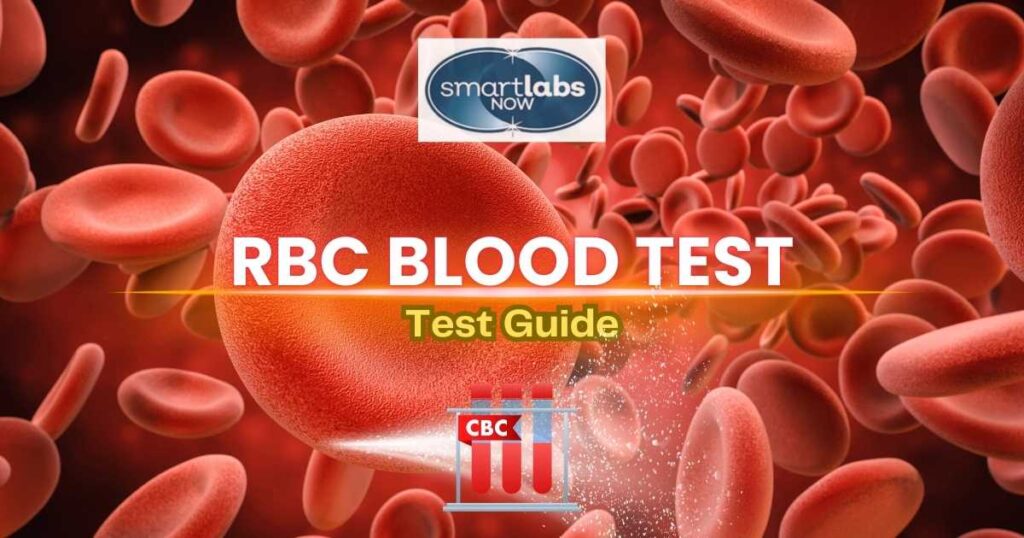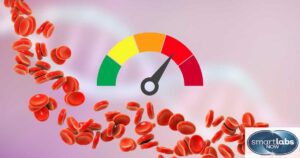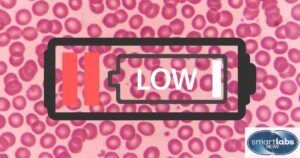
Red blood cells (RBCs) transport oxygen throughout the body, making them essential to overall health. An RBC blood test—typically part of a CBC panel—measures the number of red blood cells in your bloodstream. It can serve as a window into your health, revealing underlying conditions such as anemia, heart disease, or lung disease.
Understanding the purpose and process of an RBC blood test can empower you to take control of your health.
This article will guide you through what to expect from the test, what different results mean, and how to address high or low RBC counts.
If you’re in Portland and want to get tested right away, book here 🙂:

A high red blood cell count, also known as erythrocytosis, occurs when the number of red blood cells in your blood exceeds the normal range.
Generally, for adult males, this ‘normal’ is between 4.6 and 6.2 million cells per microliter (cells/μL). For women, it ranges from 4.2 to 5.4 million cells/μL. However, these numbers can vary based on age, hormones, labs, underlying conditions, and tested populations.
RBC count excesses can lead to increased blood thickness, impaired blood flow, and complications such as heart disease or stroke.
But how do you find out if your red blood cell count is high?
A complete blood count (CBC) is the most common diagnostic tool for understanding RBC levels. This test not only measures RBCs but also evaluates white blood cells (WBCs), platelets, hemoglobin, and hematocrit levels.
An elevated RBC count could be the first sign of a more significant health issue, such as congenital heart disease or sleep apnea.
Smokers, for example, are often more susceptible to a higher RBC count due to decreased oxygen levels in the blood caused by carbon monoxide exposure.
There are several reasons why someone might experience elevated RBC levels. Factors such as environment, lifestyle, and underlying health conditions play critical roles.
Other causes include chronic stress, erythrocytosis (overproduction of RBCs), and diseases like polycythemia vera, a rare blood cancer.
Having a high red blood cell count can cause various symptoms. These symptoms are often linked to the thicker consistency of blood, which can restrict blood flow to certain areas of the body.
Thicker blood can reduce circulation to the eyes, leading to vision problems.
Increased blood pressure due to the high RBC count can trigger frequent and severe headaches.
Poor circulation and reduced oxygen flow to the skin can result in persistent itchiness.
Some people experience discomfort in their joints due to reduced blood flow.
Excess RBCs can strain blood vessels, particularly in the nose, causing spontaneous nosebleeds.
The thickened blood may limit circulation to the extremities, causing numbness or tingling in the fingers and toes.
The increased volume of red blood cells can make it harder for the body to maintain oxygen levels, especially during physical exertion.
Fatigue is another common symptom, as the body’s organs have to work harder to maintain proper function with thicker blood.
If any of these symptoms arise, seeking medical advice is crucial, as they might indicate an underlying health issue.
Managing a high RBC count often involves addressing the underlying cause.
Preventing elevated RBC levels often requires making long-term lifestyle adjustments.
For individuals with sleep apnea, using a continuous positive airway pressure (CPAP) machine can help prevent oxygen deprivation, reducing the risk of an elevated red blood cell count.
Staying away from anabolic steroids and other drugs that stimulate RBC production can prevent complications.
Regular physical activity can help improve heart and lung function, which may prevent hypoxia and excessive RBC production.
Drinking plenty of water helps maintain blood viscosity at normal levels.
Avoid taking iron supplements unless prescribed, as excessive iron can increase RBC production.
By maintaining a balanced lifestyle and staying vigilant about potential health risks, you can significantly reduce the likelihood of developing high RBC levels.

Anemia is a condition closely tied to the red blood cells (RBCs) in our blood, specifically when the body has a low RBC count or insufficient hemoglobin, the protein in RBCs responsible for transporting oxygen.
While both low RBC count and anemia share similarities, they are distinct concepts. Anemia is often diagnosed when hemoglobin levels fall below normal ranges, typically measured in grams per deciliter (g/dL). For adult males, hemoglobin levels below 13.5 g/dL, and for adult females, levels below 12.0 g/dL may indicate anemia.
While various factors can cause anemia, including iron deficiency, vitamin deficiencies, and chronic illnesses, a low RBC count may also be a sign of other underlying health issues that require further investigation.
Anemia is more prevalent in females, especially during childbearing years, due to factors like menstruation and pregnancy, which can contribute to reduced RBCs. While males are less frequently affected by anemia, they may still experience it due to lifestyle factors, certain medications, or health conditions that impact red blood cell production.
Lifestyle adjustments can often enhance the support of healthy RBC levels. For example, moderating alcohol consumption can have a positive impact, as excessive alcohol intake is known to impair red blood cell production and may lead to deficiencies in vital nutrients like folate and vitamin B12, which are crucial for healthy RBCs.
Incorporating regular exercise into daily life is another beneficial approach. Physical activity, particularly aerobic exercise, can stimulate the body’s natural production of RBCs, promoting a healthy RBC count and enhancing oxygen transport throughout the body. Aim to include a balance of aerobic exercises, like jogging or cycling, and strength training to support overall cardiovascular health and encourage efficient RBC circulation.
Additionally, a well-balanced diet rich in iron, folic acid, and vitamin B12 can further help maintain robust RBC levels. These lifestyle modifications contribute to the production of healthy RBCs and support optimal oxygen delivery, promoting overall vitality.
Knowing when to seek medical advice for low RBC levels is essential to maintaining health, especially if experiencing symptoms like persistent fatigue, weakness, or shortness of breath. If RBC levels are significantly low, a healthcare provider may recommend specific interventions, including lifestyle changes or, in some cases, medications to stimulate RBC production.
In more severe cases, a blood cell transfusion may be necessary. This procedure can help replenish RBCs in individuals experiencing dangerously low levels due to conditions like chronic anemia or severe blood loss. A provider can also assess whether other treatments, like iron supplements or dietary adjustments, are appropriate to help stabilize RBC levels.
Regular check-ins with a healthcare provider are valuable, especially if you have existing conditions or lifestyle factors affecting your RBC levels. Staying proactive with medical advice can ensure that you receive timely interventions and support to keep RBC levels within a healthy range.

An RBC blood test is simple and typically part of a routine health checkup.
A healthcare provider will draw blood from a vein in your arm, which is then sent to a lab for analysis. The test measures the number of RBCs in a specific volume of blood alongside related markers such as hemoglobin and hematocrit levels.
The results help doctors diagnose conditions like anemia, polycythemia, or other blood-related disorders.
Undergoing an RBC count test is typically a quick and straightforward procedure, and most patients experience minimal discomfort.
During the test, a healthcare professional will cleanse the area—usually the inside of the elbow or the back of the hand—before inserting a needle to draw blood. The sensation of the needle insertion is often described as a quick pinch or slight sting, which lasts only a few seconds. For some, this might cause brief discomfort, while others might feel little to no sensation.
Once the blood is being drawn, most patients feel a slight pressure or tugging at the site, but this is generally mild. If you tend to feel faint or anxious around needles, let your healthcare provider know; they can provide additional support, such as having you lie down during the procedure.
For those concerned about bruising, slight discoloration or tenderness around the puncture site is normal. Applying gentle pressure immediately after the needle is removed and keeping the area clean can help reduce these effects.
However, individuals with specific health conditions or health-related factors should be mindful of potential complications.
For example, those with bleeding disorders, such as hemophilia, may face an increased risk of prolonged bleeding or bruising. Additionally, individuals who are immunocompromised, perhaps due to conditions like HIV/AIDS or medications that suppress immune function, might be at a slightly higher risk of infection after the blood draw. While this risk remains low in a sterile clinical environment, it’s an important consideration for such patients.
Health-related factors such as dehydration or poor circulation can also impact the blood draw process. Dehydration may make veins harder to locate, resulting in multiple needle insertions, which could increase discomfort or the risk of minor bruising. People with circulatory issues, including those related to diabetes or peripheral vascular disease, might experience slightly more discomfort, as the process of drawing blood could take longer or be less straightforward.
Overall, the RBC count test is a low-risk procedure, but being aware of these health conditions and health-related factors can help patients and healthcare providers prepare adequately for the best experience possible.

It’s important to know when an RBC count test might be necessary and when to consult a healthcare provider for possible red blood cell-related issues.
As mentioned, if you experience symptoms such as persistent fatigue, shortness of breath, dizziness, or an unusual change in skin color (such as paleness or a ruddy complexion), it may be time to seek medical advice. These symptoms could indicate abnormalities in your red blood cell levels, potentially pointing to an underlying health condition.
Your healthcare provider may recommend taking a blood sample to check your RBC levels as part of a more comprehensive blood test. This straightforward test can provide valuable insights into whether your red blood cell count is too high or too low.
A high red blood cell count may warrant further investigation, as it can be associated with conditions like heart disease, lung disease, or dehydration. If your test results indicate elevated RBC levels, your healthcare provider may discuss additional testing or treatment options to address potential causes.

Normal RBC counts vary based on age, sex, and altitude but generally range between 4.7 to 6.1 million cells per microliter for men and 4.2 to 5.4 million for women.
Yes, dehydration can temporarily increase your RBC count because there is less plasma in the blood, making the concentration of cells appear higher.
No fasting is required for an RBC test, but your doctor may give you specific instructions based on other tests being conducted.
A nucleated red blood cell (NRBC) is a red blood cell that still contains a nucleus. In healthy adults, NRBCs are typically absent from the bloodstream, as mature red blood cells eject their nuclei before entering circulation.
The presence of NRBCs in adults indicates a pathological condition often associated with:
Normal reference ranges for NRBCs in adults are typically 0 per 100 white blood cells (WBCs), with any count above this indicating potential health issues such as anemia, leukemia, or splenic dysfunction.
White Blood Cells (WBC) and Red Blood Cells (RBC) are critical components measured in a Complete Blood Count (CBC).
For questions about CBC in general, read our detailed ‘CBC Blood Test FAQs Explored‘ guide.

Understanding your RBC count can offer important insights into your health. Whether your red blood cell count is too high or too low, it’s essential to address the underlying causes and take steps to maintain a healthy balance.
If you’re in Portland, OR, and concerned about your red blood cell count, consider scheduling our quick, affordable, discreet, and accurate CBC panel. This includes detailed RBC testing. Plus, we’re available for at-home testing on request! 🙌
Please consult your primary care physician before engaging with any pharmaceutical, natural substances, or activity regimens mentioned or prescribed in this post. Smart Labs Now is not responsible for health or life outcomes based on the information or recommendations provided. This account does not serve as a substitute for professional medical advice/help.